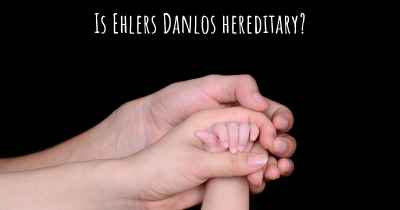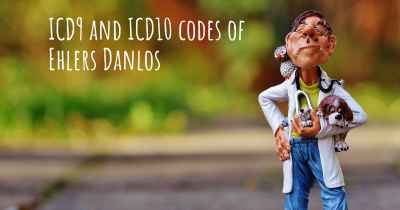Which are the symptoms of Ehlers Danlos?
See the worst symptoms of affected by Ehlers Danlos here

Ehlers-Danlos syndrome (EDS) is a group of genetic disorders that affect the connective tissues in the body. Connective tissues provide support, structure, and elasticity to various organs, joints, blood vessels, and skin. EDS is characterized by a defect in the production, structure, or function of collagen, which is the main protein in connective tissues.
Symptoms of Ehlers-Danlos syndrome can vary widely depending on the specific type and severity of the condition. There are currently 13 recognized types of EDS, each with its own set of symptoms and complications. However, some common symptoms and features can be observed across different types:
- Joint hypermobility: One of the most prominent features of EDS is increased joint flexibility or hypermobility. This can lead to frequent joint dislocations, chronic joint pain, and early-onset osteoarthritis.
- Stretchy and fragile skin: Individuals with EDS often have soft, velvety, and hyperextensible skin that is prone to easy bruising, tearing, and scarring. Wounds may heal slowly, and some individuals may develop abnormal scarring, such as atrophic scars or widened scars.
- Easy bruising and bleeding: Due to the fragility of blood vessels, individuals with EDS may experience easy bruising and prolonged bleeding after injuries or surgeries. They may also be prone to developing abnormal blood vessels, such as varicose veins or arteriovenous fistulas.
- Fatigue and muscle weakness: Many individuals with EDS report chronic fatigue and muscle weakness, which can significantly impact their daily activities and quality of life.
- Chronic pain: Joint and muscle pain are common in EDS. This pain can be widespread, chronic, and debilitating, often affecting multiple areas of the body.
- Joint instability and dislocations: The laxity of connective tissues in EDS can lead to joint instability, frequent joint dislocations, and subluxations (partial dislocations). This can cause chronic joint pain, joint deformities, and functional limitations.
- Delayed motor skills development: In some types of EDS, particularly in the hypermobility type, children may experience delays in achieving motor milestones such as crawling, walking, or running.
- Cardiovascular complications: Certain types of EDS can affect the structure and function of blood vessels, leading to cardiovascular complications. These may include aortic root dilation, mitral valve prolapse, arterial dissections, and an increased risk of aneurysms.
- Gastrointestinal issues: EDS can affect the digestive system, leading to gastrointestinal symptoms such as chronic constipation, gastroesophageal reflux disease (GERD), and functional bowel disorders.
- Autonomic dysfunction: Some individuals with EDS may experience autonomic dysfunction, which can manifest as orthostatic intolerance (difficulty maintaining blood pressure upon standing), temperature regulation problems, and gastrointestinal dysmotility.
It is important to note that the severity and combination of symptoms can vary greatly among individuals with EDS. Some individuals may have mild symptoms that do not significantly impact their daily lives, while others may experience severe symptoms that require ongoing medical management and support.
If you suspect you or someone you know may have Ehlers-Danlos syndrome, it is crucial to consult with a healthcare professional for a proper diagnosis and appropriate management strategies.
Posted Apr 11, 2017 by Montana 1670
Posted May 10, 2017 by April 100
Posted May 10, 2017 by stairphobe 3070
Posted May 25, 2017 by Maria 2051
Posted May 26, 2017 by Stephanie 800
Posted May 27, 2017 by Jude 2050
Posted May 27, 2017 by Ashley 950
The symptoms of these conditions can be debilitating. Chronic Fatigue is perhaps the 'worst' symptom in as much as it can be completely debilitating and severely limiting quality of life. Many EDS sufferers experience chronic fatigue without any diagnosis (or investigation) of comorbid neurological conditions and it is generally considered to be a symptom of EDS.
In addition, many with EDS suffer with POTS (Postural Orthostatic Intolerance) which some consider the worst symptom (subject to the intensity and frequency experienced).
The reality is that there is no way to give a comprehensive response to this question given the highly subjective and individualised nature of symptoms that differ from individual to individual.
Posted May 27, 2017 by Jay 201
Posted May 28, 2017 by Celi 2000
Posted May 31, 2017 by KathrynOConnor 2200
Learning to work with EDS ans MCAD has become my life.
Posted Aug 30, 2017 by Brenda 102
Posted Aug 30, 2017 by Jennifer Sanders 122
Posted Aug 31, 2017 by Jess Knowles 150
Posted Aug 31, 2017 by Lexie 100
Posted Sep 15, 2017 by Phyllis 150
Posted Sep 27, 2017 by Lbond94 4100
Posted Oct 6, 2017 by Amy 100
Posted Oct 6, 2017 by Sasha 2050
Posted Oct 6, 2017 by Zara 300
Bowel issues
Exhaustion
Posted Oct 7, 2017 by Sharon 7050
Posted Oct 7, 2017 by Brittany 500
Posted Oct 25, 2017 by Dolores 3050
loose joints (sublux, dislocations)
Arthritis
Muscle weakness
Profound fatigue
Skin folds on the eyes
Growths on pressure areas
Autonomic Dysfunction (Dysautonomia / POTS)
Pain
Mast Cell Disorders
Connective Tissue breakdown (Soft skin, tissue breakdown, tendon and ligament issues)
Hypermobile organs and veins
Bleeding issues (Von Willebrand)
Autism Spectrum
Autoimmune
Scoliosis
Occult Tethered Cord
Chiari Malformation
Anxiety
Dental issues
Fragile tissue
The first symptoms I would get rid of (the top three and the most debilitating)
Chronic Pain
Autonomic Dysfunction
Mast Cell Reactions
I do not wish to add milder symptoms in their place as I feel they should be completly removed all together.
However, since they can not be I would replace
Chronic Pain with typical pain from an overworked muscle as an example- that can heal (pain that has an end)
Or
proper knowledge and education of what pain is, types of pain, how each type is supposed to feel, what can be done to ease the type of pain you have, What NORMAL pain feels like to others - a goal to train the mind towards...so when a doctor asks where does it hurt', or 'describe your pain to me' a person with EDS can do that properly. As well - our own pain scale that we can show our doctors so they can follow and put in our files.
Posted May 11, 2018 by Izzy 600
Migrañas
Dolores articulares
Problema de visión
Dolores en los huesos
Deficiencia de las vitaminas más q nada la vitamina d
Fatiga
Problemas de espalda
Problemas de corazón
Taquicardia
Posted Jul 6, 2018 by Estefania 1150
Posted Mar 21, 2019 by pianocat_61 1400
Posted Sep 29, 2019 by Amy 13500
Joint hypermobility; loose/unstable joints which are prone to frequent dislocations and/or subluxations; joint pain; hyperextensible joints (they move beyond the joint’s normal range); early onset of osteoarthritis.
Soft velvety-like skin; variable skin hyper-extensibility; fragile skin that tears or bruises easily (bruising may be severe); severe scarring; slow and poor wound healing; development of molluscoid pseudo tumors (fleshy lesions associated with scars over pressure areas).
There are some symptoms that are more common in one type than the others. These can include:
Chronic, early onset, debilitating musculoskeletal pain (usually associated with the Hypermobility Type); arterial/intestinal/uterine fragility or rupture (usually associated with the Vascular Type); scoliosis at birth and scleral fragility (associated with the Kyphoscoliosis Type); poor muscle tone (associated with the Arthrochalasia Type); mitral valve prolapse; and gum disease.
Posted Mar 11, 2020 by MegTheMariner 1870
Most limiting: The fragility of the body causing injury, combined with slow healing leading to pain.
Symptoms to get rid of: Pain and slow healing. If either were gone it wouldn't be as bad.
Posted May 12, 2020 by Alex 3551
Posted Nov 19, 2021 by NuNu 2550
Posted Nov 28, 2022 by Taiy rinaldi-bull 600
Posted Mar 25, 2017 by Paula Lopez 1151
Fatigue
The dislocation/subluxation
Posted Aug 16, 2017 by Apolline 1205
The tiredness is virtually permanent
Posted Aug 17, 2017 by Sandrine 1790
Posted Aug 30, 2017 by Leilane 200
Joint pain
Muscle pain
Disorders proprioceptive
Sleep disorders
Parasthesies
Difficulties respiratory
Posted Aug 30, 2017 by Ehos 1050
Instability joint.
Heart problems and in internal organs.
Posted Aug 30, 2017 by Kayla Rarine 2000








